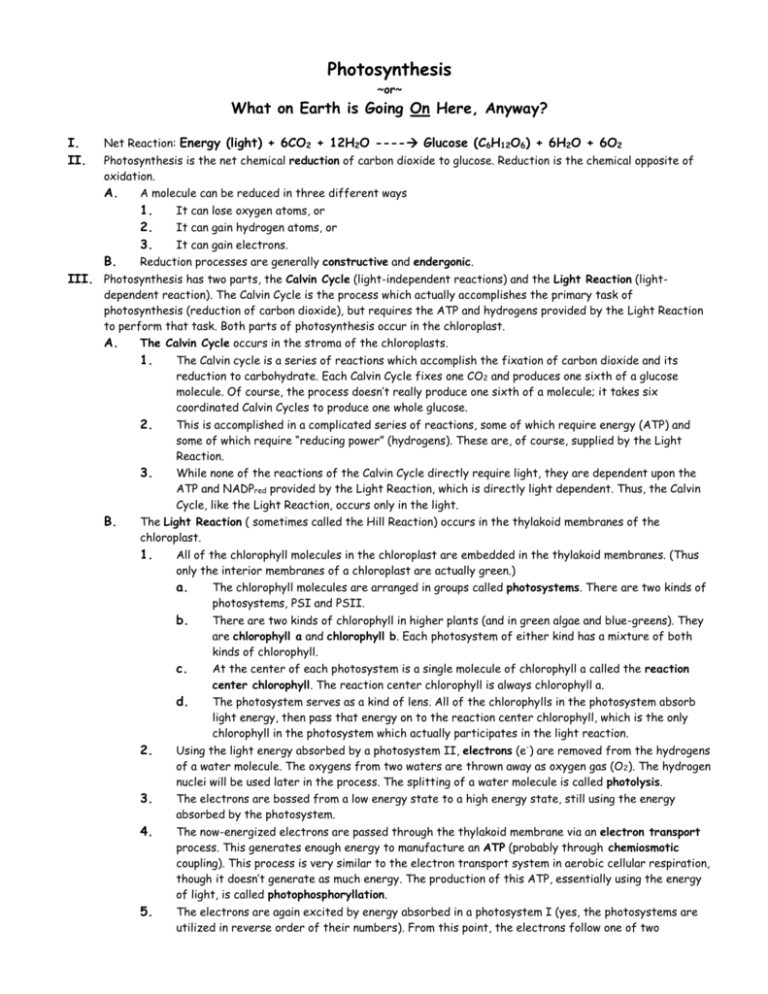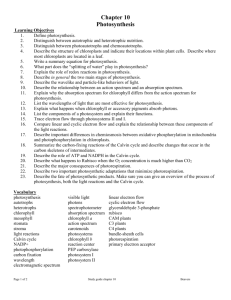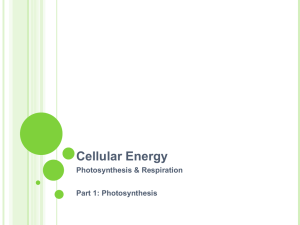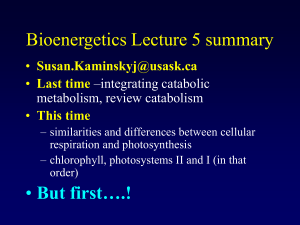Study Guide to Photosynthesis
advertisement

Photosynthesis ~or~ What on Earth is Going On Here, Anyway? I. II. Net Reaction: Energy (light) + 6CO2 + 12H2O ---- Glucose (C6H12O6) + 6H2O + 6O2 Photosynthesis is the net chemical reduction of carbon dioxide to glucose. Reduction is the chemical opposite of oxidation. A. B. A molecule can be reduced in three different ways 1. 2. 3. It can lose oxygen atoms, or It can gain hydrogen atoms, or It can gain electrons. Reduction processes are generally constructive and endergonic. III. Photosynthesis has two parts, the Calvin Cycle (light-independent reactions) and the Light Reaction (light- dependent reaction). The Calvin Cycle is the process which actually accomplishes the primary task of photosynthesis (reduction of carbon dioxide), but requires the ATP and hydrogens provided by the Light Reaction to perform that task. Both parts of photosynthesis occur in the chloroplast. A. The Calvin Cycle occurs in the stroma of the chloroplasts. 1. 2. 3. B. The Calvin cycle is a series of reactions which accomplish the fixation of carbon dioxide and its reduction to carbohydrate. Each Calvin Cycle fixes one CO2 and produces one sixth of a glucose molecule. Of course, the process doesn’t really produce one sixth of a molecule; it takes six coordinated Calvin Cycles to produce one whole glucose. This is accomplished in a complicated series of reactions, some of which require energy (ATP) and some of which require “reducing power” (hydrogens). These are, of course, supplied by the Light Reaction. While none of the reactions of the Calvin Cycle directly require light, they are dependent upon the ATP and NADPred provided by the Light Reaction, which is directly light dependent. Thus, the Calvin Cycle, like the Light Reaction, occurs only in the light. The Light Reaction ( sometimes called the Hill Reaction) occurs in the thylakoid membranes of the chloroplast. 1. All of the chlorophyll molecules in the chloroplast are embedded in the thylakoid membranes. (Thus only the interior membranes of a chloroplast are actually green.) a. b. c. d. The chlorophyll molecules are arranged in groups called photosystems. There are two kinds of photosystems, PSI and PSII. There are two kinds of chlorophyll in higher plants (and in green algae and blue-greens). They are chlorophyll a and chlorophyll b. Each photosystem of either kind has a mixture of both kinds of chlorophyll. At the center of each photosystem is a single molecule of chlorophyll a called the reaction center chlorophyll. The reaction center chlorophyll is always chlorophyll a. The photosystem serves as a kind of lens. All of the chlorophylls in the photosystem absorb light energy, then pass that energy on to the reaction center chlorophyll, which is the only chlorophyll in the photosystem which actually participates in the light reaction. 2. Using the light energy absorbed by a photosystem II, electrons (e-) are removed from the hydrogens of a water molecule. The oxygens from two waters are thrown away as oxygen gas (O 2). The hydrogen nuclei will be used later in the process. The splitting of a water molecule is called photolysis. 3. The electrons are bossed from a low energy state to a high energy state, still using the energy absorbed by the photosystem. 4. The now-energized electrons are passed through the thylakoid membrane via an electron transport process. This generates enough energy to manufacture an ATP (probably through chemiosmotic coupling). This process is very similar to the electron transport system in aerobic cellular respiration, though it doesn’t generate as much energy. The production of this ATP, essentially using the energy of light, is called photophosphoryllation. 5. The electrons are again excited by energy absorbed in a photosystem I (yes, the photosystems are utilized in reverse order of their numbers). From this point, the electrons follow one of two pathways. They may be passed again through the electron transport chain, producing another ATP (cyclic photophosphoryllation), or they may be reunited with a pair of hydrogen nuclei, reconstituting hydrogen atoms (non-cyclic photophosphoryllation). Eventually, all of the electrons will follow this second path, but some will be used in electron transport more than once. Statistically, the Light Reaction yields about 1.5 ATP per hydrogen pair. 6. 7. The hydrogen atoms become attached to NADP (nicotinamide adenine dinucleotide phosphate). NADP, like NAD and FAD in cellular respiration, is a hydrogen carrier. Accepting the pair of hydrogens converts oxidized NADP (NADPox) into reduced NADP (NADPred). The ATP and the hydrogens now carried by NADPred are passed to the Calvin Cycle to support the reduction reactions required to convert CO2 into carbohydrate. IV. Chorophyll b, carotene, and the xanthophylls are accessory pigments for photosynthesis. Only chlorophyll a can serve as the primary photosynthetic pigment. V. All of the time that a plant is in the light, both the Light Reaction and the Calvin Cycle are occurring. As soon as the light is removed, the Light Reaction stops. Less than one second later, the Calvin Cycle runs out of ATP and NADPred, so it stops, too. Plants don’t photosynthesize at night, unless you put them into artificial light. Photosynthesis has no “dark reaction.” VI. Some plants perform a form of photosynthesis called C-4 photosynthesis. The actual photosynthetic process is no different in C-4 plants than it is in other plants (often called C-3). C-4 plants have an added on process that precedes carbon fixation by the Calvin Cycle. This process actually allows them to pre-fix carbon dioxide, a process which can be performed in the dark. Thus these plants can fix CO 2 at night, then use the pre-fixed CO2 to photosynthesis during the day. But the Calvin Cycle still occurs only in the light. VII. Plants perform aerobic cellular respiration day and night, and the chemistry of respiration in plants is identical to that in animals. A. B. C. During the night, plants use O2 and release CO2, just like animals, because they are doing respiration, but since there’s no light, they can’t perform photosynthesis. During the day, plants perform both photosynthesis and cellular respiration. However, they perform more photosynthesis than respiration, and thus their net gas exchange is CO2 in and O2 out. Essentially, the gas exchange from photosynthesis hides that from cellular respiration. There are several reasons a plant does more photosynthesis than respiration. It must of course do enough photosynthesis to satisfy its immediate respiration needs. It must also store carbohydrate for use in respiration when the light goes away. Like animals, plants must perform cellular respiration constantly to maintain life, so there must be carbohydrate available even at those times when photosynthesis can’t run. In addition, plants also use the carbohydrates produced by photosynthesis to create their primary building material, cellulose. All plant cell walls are made at least partially of cellulose, and plants have open ended growth. This means that they grow constantly throughout their lives. Thus they have a constant need to construct new cell walls, and a constant need for more cellulose.








